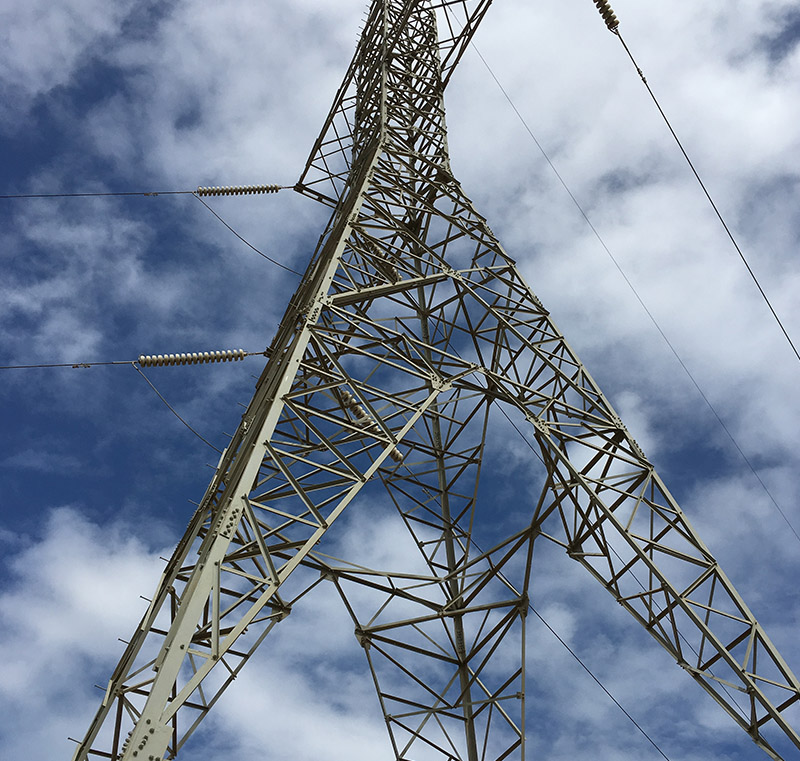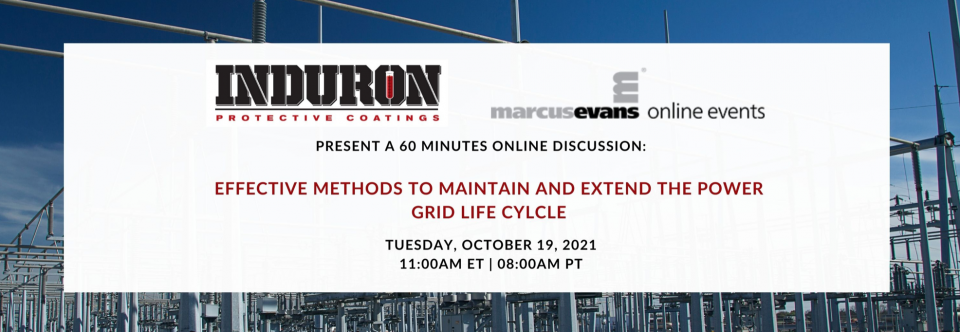By: Kendall Smith, Induron Power Market Manager
 Induron Protective Coatings is proud to announce an upcoming webinar with Marcus Evans (ME) regarding corrosion control and protective coatings for the electric utility industry, specifically the transmission and distribution (T&D) sector.
Induron Protective Coatings is proud to announce an upcoming webinar with Marcus Evans (ME) regarding corrosion control and protective coatings for the electric utility industry, specifically the transmission and distribution (T&D) sector.
Join Davies Hood, president of Induron Coatings and two top-level executives of electric utilities as well as specialized coatings contractors, who actually do the work on Oct. 19 at 11 a.m. EST.
If your utility owns high-voltage lattice towers, metal poles, or substation structures, it may be very helpful to listen in and learn how corrosion/coatings programs can be built at no cost to the utility owners, and the plans turned into reality!
To build a corrosion control program, Induron first meets with the utility to discuss evaluating the T&D system within that company, which can easily include structures covering many states. Next, Induron can survey the system, or just one line, to evaluate the current corrosion condition (R-1 to R-5), the corrosiveness of the environment (from C-1 to c-x), then create a blueprint for a corrosion control program.
The Corrosion Process for Galvanized Steel
In the U.S., the galvanizing process can provide roughly 30-40 years of corrosion resistance, depending on the environment. At that point, the zinc carbonate begins to break down into varying levels of corrosion. Once corrosion starts, it accelerates rapidly. At this time, painting is an effective way to reduce corrosion and/or slow down the corrosion process.
- New galvanized steel has a pure film of zinc on the substrate.
- Almost immediately, that zinc oxidizes, becoming zinc oxide.
- Then, once humidity or any moisture is introduced, the zinc oxide converts to zinc hydroxide.
- After approximately 12 to 18 months, a zinc carbonate forms, which provides a barrier coating that protects the steel. Zinc carbonate can be painted but doesn’t necessarily need to be.
- Approximately 30-40 years later, the zinc carbonate begins to break down and the corrosion process begins.
- Once the galvanized layer wears away, from a high level of zinc to increasingly iron and zinc, orange, brown and yellow staining will begin to appear. This is a sign that not much of the zinc remains.
- Once the zinc is depleted, you are dealing with the metal structure that has essentially no galvanizing remaining. At this point, the corrosion rate will skyrocket! You may see a structure that has looked perfect for 30 years deteriorate in less than 10 years to solid rust.
At Induron Protective Coatings, we find ourselves traveling across the world to visit electric utilities with T&D corrosion issues at an increasing rate. Thanks to the new age of global marketing, people in faraway places are discovering that Induron offers cost-effective solutions for protecting global T&D assets. Plus, Induron’s sales and technical service team members are certified as NACE coating inspectors and have extensive experience managing asset protection programs.
What’s the problem?
Utility owners rely on galvanized structures to last for the useful life of the T&D asset, but they often find that the environments that the structures reside in are very corrosive. Consequently, the galvanized steel begins to corrode much sooner than anticipated. In other cases, utility owners aim to keep the galvanized layer “new” by using a zinc-rich coating, but they find it impossible to accomplish. Getting back to the clean, metal surface required for zinc-rich coatings to be effective is very expensive and logistically difficult. Others try to “recharge” the galvanized steel, but discover they are applying zinc-rich coatings over a non-conductive zinc carbonate, which wastes the value of the zinc-rich coating. We can show you an easy test with a digital multimeter that proves that you are getting zero sacrificial protection from the zinc-rich coatings.
What’s the solution?
Induron created a coating that is best used when the galvanized substrate is fully weathered—and in many cases, covered with rust. Simply clean the structure with a hand tool (in most cases), apply the one or two coat system, and expect a full 20-25-year life of protection! The savings over the 60-100-year life of the asset are enormous!
For example, here in New England, if you get 40 years out of the galvanized structure without doing anything to it, and then coat it with Induron products, you have only had to coat it one time for the first 65 years. The structure might be 85-90 years old by the time you apply coatings again. We have coated 100-year-old lattice towers in the Northeast that have no section loss at all to provide 100% protection for 70 of the 100 years in only two recoats.
InduraPlan
With an in-house corrosion expert and engineer specialized in corrosion inspection and training, you can establish a program on your own. However, if you don’t have this expertise in-house, Induron’s InduraPlan program is a great place to start. An Induron representative can help you set up a fundamental asset protection program that will extend the life of your T&D assets so that you can avoid replacing T&D structures.
There are electric utilities who have figured out how to re-classify T&D coatings as CapEx vs. OpEx, which frees up more money to start coating programs. Induron can help you with that as well as survey the level of corrosion, determine the degree of cleaning and surface preparation required and offer the most cost-effective, long-lasting coating system.
All in all,when comparing an asset protection program with a “project approach,” the asset protection program wins every time. After all, an effective asset protection program empowers you to attain a fully protected grid!





